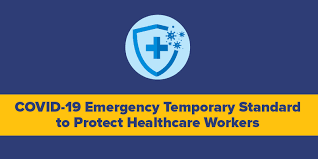
The first compliance deadline for new COVID-19 workplace requirements for healthcare providers came and went Tuesday, with no response from the federal government to a plea from the senior living industry for a delay.
LeadingAge President and CEO Katie Smith Sloan sent a letter Friday to the Occupational Safety and Health Administration requesting a six-month delay of the compliance dates for the COVID-19 Emergency Temporary Standards for healthcare settings. Sloan said she hoped that punitive measures would not be taken against aging service providers during the initial enforcement period, and that the industry’s “good faith efforts” would be considered.
The standards were announced in June alongside new general industry guidance for fully vaccinated individuals. They require operators to conduct hazard assessments and have written plans to mitigate the spread of the coronavirus, provide some employees with N95 respirators and other personal protective equipment, and follow protocols for social distancing, employee screening, and cleaning and disinfecting. Assisted living and other employers also must encourage employees to get vaccinated, as well as provide workers with paid time off to get vaccinated and to recover from any vaccine-related side effects.
The new COVID-19 workplace safety rules will affect approximately 10.3 million employees in assisted living communities, nursing homes, home healthcare agencies and other healthcare settings
The requirements were effective immediately upon their June 21 publication in the Federal Register. Compliance dates came on Tuesday for most provisions, with no response from OSHA regarding the requested delay, a LeadingAge spokesperson told McKnight’s Senior Living. Provisions related to barriers, ventilation systems and training have a compliance deadline of July 21.
“This is too short of a timeframe for long-term care and other healthcare providers to digest the requirements of the ETS, as well as change policies and procedures to comply with the intricacies of the ETS,” Sloan’s letter reads. “The new requirements in this lengthy and intricate ETS will take time to implement — more than the 14-day and 30-day compliance dates specified in the ETS.”
Implementing the charges, Sloan noted, requires analysis, and providers need time to procure the materials to adhere to barrier and ventilation requirements. The association also contends that confusion exists about how the requirements relate to or conflict with the “myriad of other guidance that pertains to aging services providers from the Centers for Disease Control, Centers for Medicare and Medicaid Services, and state regulatory agencies.”
Sloan also requested an extension of the July 21 comment deadline to Aug. 20, to allow assisted living operators, nursing homes and other long-term care providers time to analyze and prepare comments for review. Calling the short timeframe “unrealistic to give thorough and thoughtful comments,” Sloan asked for an additional 30 days to “more adequately gauge how these requirements impact members.”




